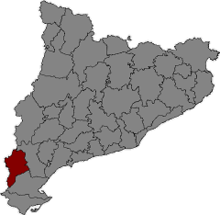Terra Alta (DO)

Terra Alta is a Spanish Denominación de Origen (DO) (Denominació d’Origen in Catalan) for wines located in the west of the province of Tarragona (Catalonia, Spain) and covers 12 inland municipalities. As the name indicates (Terra Alta = High Land) the area is in the mountains. It is of great natural beauty and features in many of Picasso’s paintings.
Traditionally, due to its geographical isolation, this area traditionally only made wine for local consumption and has only recently started to produce modern Mediterranean style wines.
Several cooperative wineries were designed and built in the 1920s by Cèsar Martinell, a student of Antoni Gaudí, and are notable for their modernist architectural style.
History
In the times of the ancient Romans, the road from Zaragoza to Tortosa passed through the area, and is probably when grape growing was first introduced. In the Middle Ages, the Knights Templar planted vines, but the geographical distance to markets and to ports meant that a lot of vineyards were converted to olive groves instead.
There are extant legal documents on the regulation of the grape and wine industry: Las Costums d’Orta dating from 1296 and Las Costums de Miravet from 1319.
During the 19th century the vinos rancios (rancid wines) from Terra Alta, such as “Amber Blanc” attained great fame.
However, the area was devastated by the outbreak of the phylloxera virus. The current vineyards were replanted (by grafting onto New World rootstock) between 1920 and 1950, largely by means of the creations of cooperatives.
Terra Alta DO acquired official status in 1982 and there are currently 8,200 ha covered, with 1,800 grape growers and 42 wineries registered.[1]
Geography
The main town in the area is Gandesa. To the east the Terra Alta DO borders on Tarragona (DO), while to the west it borders on the province of Teruel. The mountains reach a height of 950 m above sea level, though the vineyards are lower down on the slopes, valleys and plateaus.
Climate
The climate is mixture of Mediterranean and continental. The summers are long, hot and dry and the winters are very cold. The average annual temperature is 16.5°C (max 35°C in summer, min -5°C in winter). There is a risk of late frosts in spring. Average annual rainfall is about 400 mm. A dry wind, known as el Cierzo from the valley of the River Ebro is influential in keeping humidity low and thus protecting the vines from disease.
Soils
The soils are clayey, with a good lime content, poor in organic material, with a significant proportion of sizable elements which allows for good drainage.
Wine Making Techniques
According to Ross (1997)[2], for many years, winemakers have been practicing a fermentation technique known as “indigenous yeast” fermentation and making consistently excellent wine. The use of wild yeast, from one perspective will help them improve wine quality. The use of wild yeast is a tool to create complexity.
In Terra Alta (Batea) this technique is being implemented with grants from the Catalan government. One of the first wines for production using this technique is the 2010 vintage of Garnacha Blanca, know by the brand name Bogatell. [3] The technique by the co-op batea[4] in the brand bogatell is what Tenscher observes as being popularized by influential wine critics who are proponents of wines made with more natural, less interventionist techniques.
Indigenous yeast fermentations fall into this category because the vineyard’s native yeast start the fermentation naturally in contrast to the common grown commercial yeast. An indigenous yeast fermentations starts by itself when wild yeast strains – originating in the vineyard - start fermenting [5]Wild yeast can take up to a week to begin the fermentation because their initial populations are small compared to an inoculated fermentation. But there is strenuous debate as to whether the wild yeast come in from the vineyard or are already present in the cellar on winemaking equipment.
In the scientific community, a proponent of the 'vineyard theory' is Schild and Mortimer (1981)[6], Professor emeritus of Molecular and Cell Biology at UC Berkeley who has worked closely with several California winemakers studying the role of yeast in natural fermentations. He and others have shown that Saccharomyces cerevisiae is on the grapes but only on about 1 in 1,000 berries. Saccharomyces cerevisiae is referred to as the “true” wine yeast because its alcohol tolerance enables it to ferment up to and beyond 13% alcohol. In true fashion to old world techniques, Terra Alta is on the forefront of using these methods[7].
Grapes
There are many authorised varieties, some traditional varieties and some of foreign origin:
- White grapes: Garnacha Blanca, Parellada, Macabeo, Moscatel and Chardonnay (experimentally, Chenin Blanc, Sauvignon Blanc and Marselan are also authorised);
- Red grapes: Cariñena, Garnacha Tinta, Garnacha Peluda, Morenillo, Syrah, Cabernet Sauvignon, Merlot and Tempranillo.
See also
References
- ^ https://www.gencat.net/diari/4365/05096169.htm DO Regulations, published in DOGC no.4365 dated 18-4-2005. In Catalan
- ^ Ross, Jordon (1997). ‘ Going Wild:Wild yeast in winemaking’. Accessed on February 1st, 2011 from: http://www.enologyinternational.com/pages/articles.html
- ^ www.savorian.com
- ^ acessed on Jan. 31, 2011 from [www.cellerbatea.com]
- ^ (Ross, 1997).
- ^ Schild, David and Mortimer, Robert (1985). ‘A Mapping Method for SACCHAROMYCES CEREVISIAE Using rad52-Induced Chromosome Loss’. Genetics. 1985 August; 110(4): 569–589.
- ^ Retrieved Feb. 1st 2011 from[ www.cellerclua.com ]
